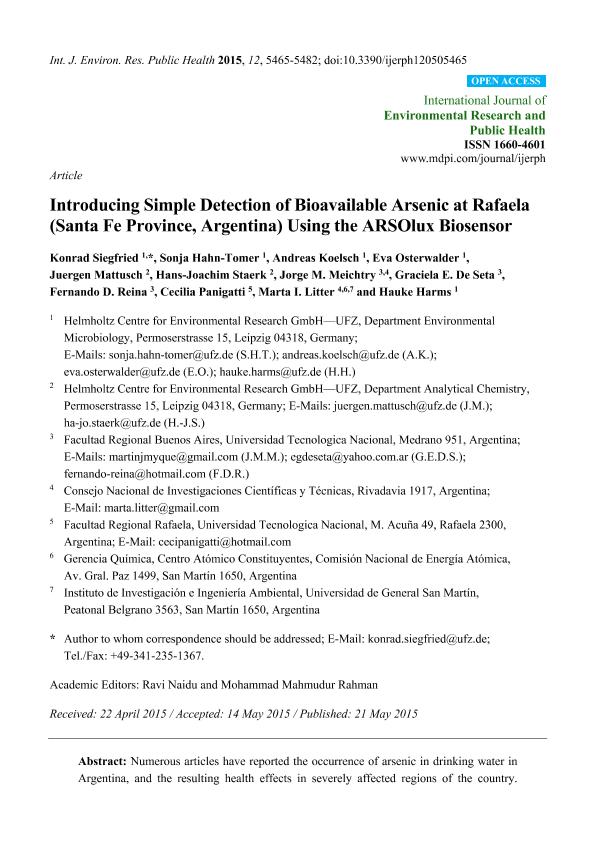Mostrar el registro sencillo del ítem
dc.contributor.author
Siegfried, Konrad
dc.contributor.author
Hahn Tomer, Sonja
dc.contributor.author
Koelsch, Andreas
dc.contributor.author
Osterwalder, Eva
dc.contributor.author
Mattusch, Juergen
dc.contributor.author
Staerk, Hans Joachim
dc.contributor.author
Meichtry, Jorge Martin

dc.contributor.author
De Seta, Graciela E.
dc.contributor.author
Reina, Fernando D.
dc.contributor.author
Panigatti, Maria Cecilia

dc.contributor.author
Litter, Marta Irene

dc.contributor.author
Harms, Hauke
dc.date.available
2018-03-26T19:01:28Z
dc.date.issued
2015-05
dc.identifier.citation
Siegfried, Konrad; Hahn Tomer, Sonja; Koelsch, Andreas; Osterwalder, Eva; Mattusch, Juergen; et al.; Introducing simple detection of bioavailable arsenic at Rafaela (Santa Fe Province, Argentina) using the ARSOlux biosensor; Molecular Diversity Preservation International; International Journal of Environmental Research and Public Health; 12; 5; 5-2015; 5465-5482
dc.identifier.issn
1660-4601
dc.identifier.uri
http://hdl.handle.net/11336/39968
dc.description.abstract
Numerous articles have reported the occurrence of arsenic in drinking water in Argentina, and the resulting health effects in severely affected regions of the country. Arsenic in drinking water in Argentina is largely naturally occurring due to elevated background content of the metalloid in volcanic sediments, although, in some regions, mining can contribute. While the origin of arsenic release has been discussed extensively, the problem of drinking water contamination has not yet been solved. One key step in progress towards mitigation of problems related with the consumption of As-containing water is the availability of simple detection tools. A chemical test kit and the ARSOlux biosensor were evaluated as simple analytical tools for field measurements of arsenic in the groundwater of Rafaela (Santa Fe, Argentina), and the results were compared with ICP-MS and HPLC-ICP-MS measurements. A survey of the groundwater chemistry was performed to evaluate possible interferences with the field tests. The results showed that the ARSOlux biosensor performed better than the chemical field test, that the predominant species of arsenic in the study area was arsenate and that arsenic concentration in the studied samples had a positive correlation with fluoride and vanadium, and a negative one with calcium and iron.
dc.format
application/pdf
dc.language.iso
eng
dc.publisher
Molecular Diversity Preservation International

dc.rights
info:eu-repo/semantics/openAccess
dc.rights.uri
https://creativecommons.org/licenses/by/2.5/ar/
dc.subject
Argentina
dc.subject
Bioavailable Arsenic
dc.subject
Biosensor
dc.subject
Chaco Pampean Plain
dc.subject
Ground Water
dc.subject.classification
Otras Ciencias Químicas

dc.subject.classification
Ciencias Químicas

dc.subject.classification
CIENCIAS NATURALES Y EXACTAS

dc.title
Introducing simple detection of bioavailable arsenic at Rafaela (Santa Fe Province, Argentina) using the ARSOlux biosensor
dc.type
info:eu-repo/semantics/article
dc.type
info:ar-repo/semantics/artículo
dc.type
info:eu-repo/semantics/publishedVersion
dc.date.updated
2018-03-09T14:44:13Z
dc.journal.volume
12
dc.journal.number
5
dc.journal.pagination
5465-5482
dc.journal.pais
Suiza

dc.journal.ciudad
Basilea
dc.description.fil
Fil: Siegfried, Konrad. Helmholtz Centre for Environmental Research; Alemania
dc.description.fil
Fil: Hahn Tomer, Sonja. Helmholtz Centre for Environmental Research; Alemania
dc.description.fil
Fil: Koelsch, Andreas. Helmholtz Centre for Environmental Research; Alemania
dc.description.fil
Fil: Osterwalder, Eva. Helmholtz Centre for Environmental Research; Alemania
dc.description.fil
Fil: Mattusch, Juergen. Helmholtz Centre for Environmental Research; Alemania
dc.description.fil
Fil: Staerk, Hans Joachim. Helmholtz Centre for Environmental Research; Alemania
dc.description.fil
Fil: Meichtry, Jorge Martin. Universidad Tecnológica Nacional. Facultad Regional Buenos Aires; Argentina. Consejo Nacional de Investigaciones Científicas y Técnicas; Argentina
dc.description.fil
Fil: De Seta, Graciela E.. Universidad Tecnológica Nacional. Facultad Regional Buenos Aires; Argentina
dc.description.fil
Fil: Reina, Fernando D.. Universidad Tecnológica Nacional. Facultad Regional Buenos Aires; Argentina
dc.description.fil
Fil: Panigatti, Maria Cecilia. Universidad Tecnológica Nacional. Facultad Regional Rafaela; Argentina
dc.description.fil
Fil: Litter, Marta Irene. Consejo Nacional de Investigaciones Científicas y Técnicas; Argentina. Universidad Nacional de San Martín; Argentina. Comisión Nacional de Energía Atómica. Centro Atómico Constituyentes; Argentina
dc.description.fil
Fil: Harms, Hauke. Helmholtz Centre for Environmental Research; Alemania
dc.journal.title
International Journal of Environmental Research and Public Health

dc.relation.alternativeid
info:eu-repo/semantics/altIdentifier/doi/http://dx.doi.org/10.3390/ijerph120505465
dc.relation.alternativeid
info:eu-repo/semantics/altIdentifier/url/http://www.mdpi.com/1660-4601/12/5/5465
Archivos asociados
